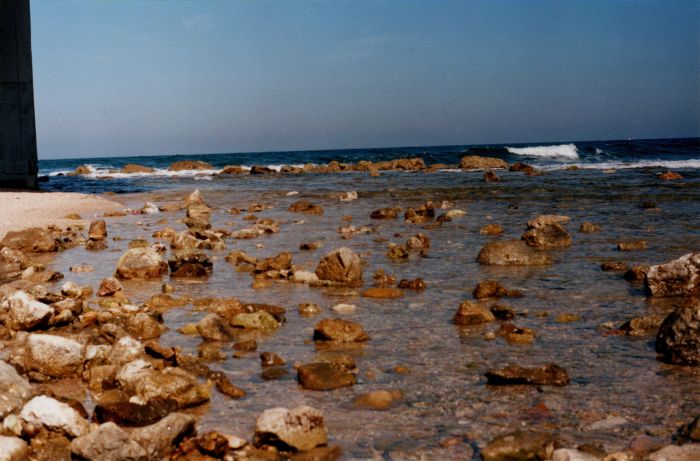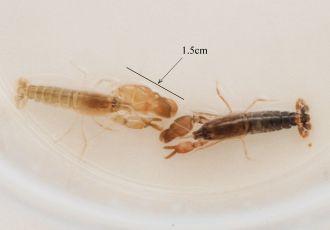Snapping shrimp (members of the family alpheidae) are small cryptic crustaceans that have no commercial value and I’ve never seen one in a fish market or an aquarium store. Not easily observed by casual snorkelers or divers they live hidden in burrows made deeply under rocks, inside sponges or in other nooks and crannies. Yet their clicking and popping sounds are easy to detect if you go swimming or snorkeling near rocks or other hard bottom (snapping shrimp don’t live in sand) because these small creatures are among the noisiest in the sea competing with whales for that distinction. Their noise is sometimes so loud that it interferes with submarine communications.
It was their noise that first alerted me to their presence outside the office where I was then working on slipper lobsters. Slipper lobsters live at a depth of at least 10 meters. That means that to reach them and study them it requires everything associated with diving: for example, a boat, dive team, dive equipment. I was now doing research on my own, trying unsuccessfully to fund my own research and it came to me that working with the fascinating noisy creatures that lived right outside my office window would be a lot easier! With the help of my sons and husband I went out at a good low tide, collected several and started watching them. From that point on I was hooked.

The sound is made by the larger asymmetric claw that all snapping shrimp have which distinguishes this family of crustaceans. They open the claw like cocking a gun, and snap it closed so fast that a low pressure area is created near the claw making a vacuum that explosively collapses. The collapse of the vacuum makes the noise. It also blasts out a stream of water strong enough to stun prey without the claw touching. There are over 400 different species of snapping shrimp many of which are so similar they are difficult to tell apart. They are the most social of all the crustaceans and there are even a few species of snapping shrimp that live together in sponges with a social organization similar to bees in hives.
I have collected 6 different species of snapping shrimp off the coast of Haifa, and all but one of them was originally from the Red Sea like many different organisms that made their way through the Suez Canal to colonize the Mediterranean Sea. In some cases the invaders have displaced the local species. Little is known about the behavior or ecology of the majority of snapping shrimp species and that is true of the shrimp I choose to study Alpheus audouini (pronounced awdweeni). Audouinis are also originally from the Red Sea, but now live all along our Mediterranean coast in the rocky intertidal zone, and for several years I collected them in the field and then observed the shrimp interact with each other and with other prey.

I often found males and females together in the field. It turns out that these male/female pairs were bonded. The pairs lived together in one shelter even if there were other equally good shelters available, didn’t fight with each other, hunted together, and shared food. Many times a male was able to subdue a crab and then brought the crab to the shelter where both female and male ate it together - a marine example of a good provider! While most of the time it was the male with its larger claw that made the kill, the females also hunted the crabs.
When I placed two males together the Audouini lived in separate shelters as far from each other as they could, tried to evict each other, fought over food, and when one of the males molted and became vulnerable the other killed and ate it. When I placed unpaired males and females in a tank together they eventually cohabited the same shelter, but there were clear differences in their relationship compared to the bonded pair and those differences culminated when one of the pair molted. Bonded pairs didn’t kill each other, but un-bonded pairs, if one of the pair molted, the other shrimp killed and ate it.
My experiments were actually designed to examine whether the Audouini shrimp used the powerful snap of their claw to stun prey. What I found was a behavior that has never been described before. When I placed a small crab in the tank with the Audouinis they would kill the crab outright by aiming a snap between the eyes of the crab, this blow to the head was incredible to watch, and it’s about what I expected. However, if the crab was closer to the size of the shrimp itself, than the approach was more hesitant. Between these two types of animals who is prey and who is predator is completely dependant on size. So the Audouini would approach the larger crab carefully and then snap toward the base of any of the crab’s ten limbs. All crustaceans have the ability to give up (autotomize) a limb as a strategy to escape being captured much like lizards dropping their tails. When the Audouinis snapped at the base of the limb the crab would drop its own leg or claw. Then the Audouini took the limb back to the safety of its shelter and shared the meal with its mate. In nature the crab would very likely go about its life and regenerate its lost limb. If I placed a crab in the tank that was much larger than the Audouini than the shrimp stayed in their shelter and would not attempt to get a limb.
These observations were all done in specially designed aquaria not in the field. They can only give us an approximation of what really happens in nature. For example, it is probably rare that male Audouini kill each other after molting because in nature they would be further away from each other and in better shelters than they were in my tanks. However, from looking intimately at the lives of Alpheus audouini I now have the questions to ask for further experiments.
Next time you hear the clicking and popping noise when you’re in the sea you will know what is happening in the secrete lives of snapping shrimp.
Interesting links:Here is an excellent presentation about the snapping of snapping shrimp.
Here you can see a rather over dramatized BBC film about snapping shrimp.
To Article about Carpenter Bees
To Article about Golden Jackals
The picture in the Banner is used with permission from the Southeastern Regional Taxonomic Center, South Carolina Department of Natural Resources.